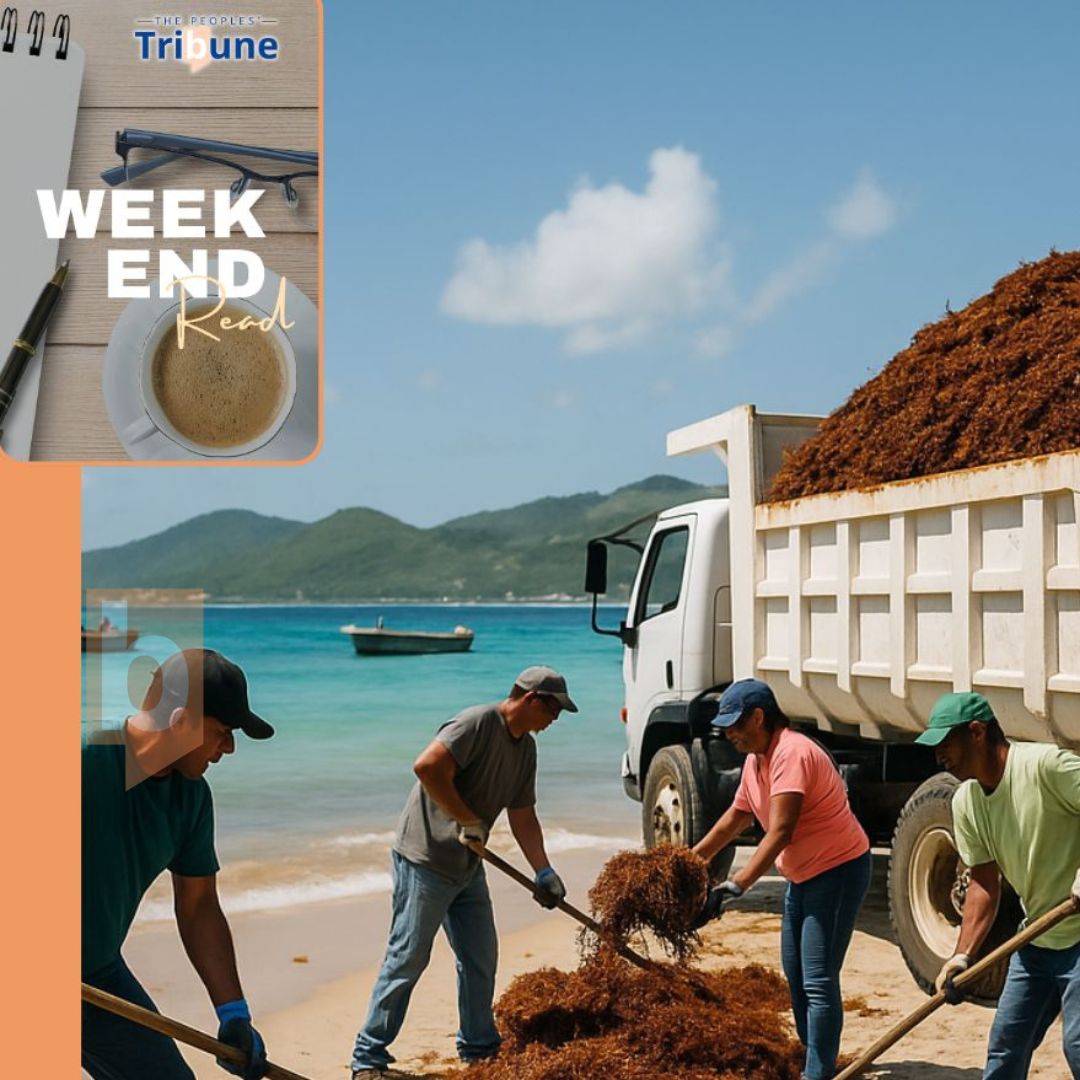EU and Caribbean partners seek to turn Sargassum into a new market

The seaweed comes quietly at first, like a shadow spreading across the turquoise shallows. Then, within days, it is everywhere, thick mats of brown sargassum stretching for miles, smothering coastlines, shutting down fisheries, and silencing beaches that once hummed with tourists. For more than a decade, this seasonal invasion has battered the Caribbean, costing governments and coastal communities millions each year in cleanup and lost revenue.
But this year, the conversation shifted from crisis to conversion. Through the European Union’s Global Gateway Investment Agenda, the EU, Team Europe, and Caribbean partners are attempting to turn the region’s most visible environmental nuisance into a new market. The third EU-Caribbean Global Gateway Conference on Sargassum, held in Grenada in 2025, marked that pivot: from research papers and pilot projects to action, from seeing sargassum as waste to treating it as a resource.
𝐂𝐫𝐢𝐬𝐢𝐬? 𝐍𝐨, 𝐎𝐩𝐩𝐨𝐫𝐭𝐮𝐧𝐢𝐭𝐲
For years, the sargassum tide has symbolised everything that makes the Caribbean vulnerable; climate instability, dependence on tourism, and fragile coastal economies. Now, policymakers hope it can also become a symbol of innovation.
At the conference, EU Commissioner for International Partnerships Jozef Síkela captured the shift in tone. “The sargassum crisis has been a persistent challenge for Caribbean communities, harming local livelihoods and causing costly damage to tourism, one of the region’s key economic sectors. But together, we are proving that this crisis can be turned into an opportunity – a source of jobs, innovation, and even clean energy across the region – by building value chains from sargassum.”
Grenada, the Dominican Republic, and Mexico each pledged to collect and process significant volumes of the seaweed between 2026 and 2027, 10,000 tonnes in Grenada, 150,000 tonnes in the Dominican Republic, and 500,000 tonnes in Mexico. These commitments are the first formal steps toward building a regional market for sargassum-based products.
The concept is simple: move beyond endless cleanup operations and build small industries that use sargassum for compost, construction materials, packaging, and renewable energy. The EU’s backing aims to ensure that this transition is not just environmental but also economic — linking science, entrepreneurship, and community resilience.
𝐓𝐡𝐞 𝐰𝐞𝐢𝐠𝐡𝐭 𝐨𝐟 𝐚 𝐝𝐞𝐜𝐚𝐝𝐞
Since 2011, sargassum has washed ashore almost every year, its arrival now tracked like a storm. The floating algae originate in the Atlantic’s Sargasso Sea, where changing ocean temperatures and nutrient flows, tied to climate change and agricultural runoff, fuel explosive blooms. By the time they reach the Caribbean, the drifts can cover thousands of square kilometres, fouling beaches, damaging marine habitats, and releasing hydrogen sulphide gas that drives away both fish and tourists.
In 2018, the University of South Florida estimated that the Great Atlantic Sargassum Belt stretched over 8,000 kilometres, the largest bloom ever recorded. In 2023 and 2024, satellite monitoring showed record buildups again, hitting the Dominican Republic, Barbados, St Lucia, Martinique, and parts of Mexico especially hard. Cleanup costs now run into tens of millions of dollars each season, and smaller islands often struggle to keep up.
𝐀 𝐜𝐨𝐨𝐫𝐝𝐢𝐧𝐚𝐭𝐞𝐝 𝐫𝐞𝐬𝐩𝐨𝐧𝐬𝐞
Under the EU’s Global Gateway framework, sargassum management became a priority in 2023. The strategy connects governments, researchers, investors, and civil-society groups to design solutions that are both economically viable and environmentally sound.
The EU and its partners have helped create national task forces in Grenada, the Dominican Republic, and Mexico to coordinate collection and processing. Expressions of interest are being used to attract private-sector participation and academic research. The broader goal is to mobilise finance and technical expertise to develop an integrated value chain, turning sargassum into fertilizer, bio-plastics, feedstock, and even bio-gas.
For Caribbean governments, the initiative also represents something rarer than money: coherence. For years, countries fought the tide individually, testing small machines or relying on emergency cleanup crews. The new framework brings them under one umbrella, linking policy, funding, and research.
The Grenada conference closed with an announcement that the fourth EU-Caribbean Global Gateway Conference on Sargassum will be held in Mexico in 2026, ensuring that the momentum continues and that regional benchmarks can be tracked over time.
𝐄𝐜𝐨𝐧𝐨𝐦𝐢𝐜 𝐡𝐨𝐩𝐞, 𝐞𝐜𝐨𝐥𝐨𝐠𝐢𝐜𝐚𝐥 𝐜𝐚𝐮𝐭𝐢𝐨𝐧
The emerging sargassum economy carries promise but also warning. Poorly managed harvesting could harm near-shore ecosystems or release trapped toxins. Scientists stress the need for environmental safeguards and consistent quality standards. The EU’s role as convener includes not just mobilising investment but ensuring oversight, building “value chains that don’t trade one environmental crisis for another.”
Still, the scale of potential benefit is clear. For small island economies grappling with unemployment, foreign-exchange pressure, and post-pandemic debt, sargassum offers a rare local resource that is both abundant and renewable. In Grenada, officials are already discussing pilot projects for small-scale processing plants. In the Dominican Republic, entrepreneurs are exploring biodegradable packaging made from seaweed pulp. And in Mexico, existing facilities are being upgraded to feed sargassum into biogas generation.
𝐀 𝐜𝐥𝐞𝐚𝐧𝐞𝐫 𝐜𝐨𝐚𝐬𝐭, 𝐚 𝐰𝐢𝐝𝐞𝐫 𝐯𝐢𝐞𝐰
Beyond the economics, there is a psychological dimension. Sargassum’s annual invasions have become a kind of seasonal trauma for many Caribbean residents. Fishermen see their boats stranded in weed-clogged harbours, hotel workers are sent home, beachgoers avoid the stench. The ability to plan — to say we know what to do when it arrives, offers a form of collective relief.
That makes this initiative more than an environmental policy; it is a bet on stability, on mental and economic resilience across coastal communities. If the strategy works, the Caribbean could move from reactive cleanup to a circular economy that feeds itself.
𝐓𝐡𝐞 𝐥𝐨𝐧𝐠 𝐯𝐢𝐞𝐰
The EU’s Global Gateway strategy is vast, aiming to mobilise up to €300 billion worldwide by 2027 in smart, clean, and secure infrastructure. The Caribbean’s sargassum program sits at the intersection of that ambition and the region’s lived reality. It brings together government, academia, and private enterprise under one simple idea: that what the sea delivers each year need not be only a curse.
As one Grenadian delegate put it at the close of the conference, “We cannot stop the sargassum, but we can stop treating it like garbage.”
With the next Global Gateway Conference scheduled for Mexico, the tide, both literal and political, appears to be turning. The Caribbean, long defined by what washes ashore, is learning to build with it instead.

